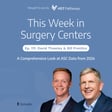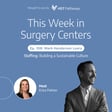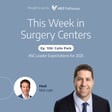
Janet Carlson – Optimizing the Physician Experience: Communication and Collaboration
Today is the third and final part of our three-part series on how you can optimize the physician experience. Dr. Justo covered the importance of encouraging your doctors to learn new procedures, Lindsay Schulte covered how to ensure you're fully aligned with your doctor's preferences, and Janet Carlson joined us on this episode to discuss improving communication and collaboration. Janet is the Executive Director of ASCs at Commonwealth Pain and Spine, and they have roughly 22 doctors, so she shared tips for removing some common barriers, technology's role, and how they do things at Commonwealth.
After my conversation with Janet, we'll wrap up the episode with the third installment of our AI segment. We've covered ways you can use generative AI to create staff schedules, write patient education materials, handle the heavy lifting when writing post-op instructions, improve your website, and manage your social media content. Today, we'll take it one step further and look at five ways you can use AI to help you analyze data, spot trends, and present your findings to your board or stakeholders.
Brought to you by HST Pathways.



















